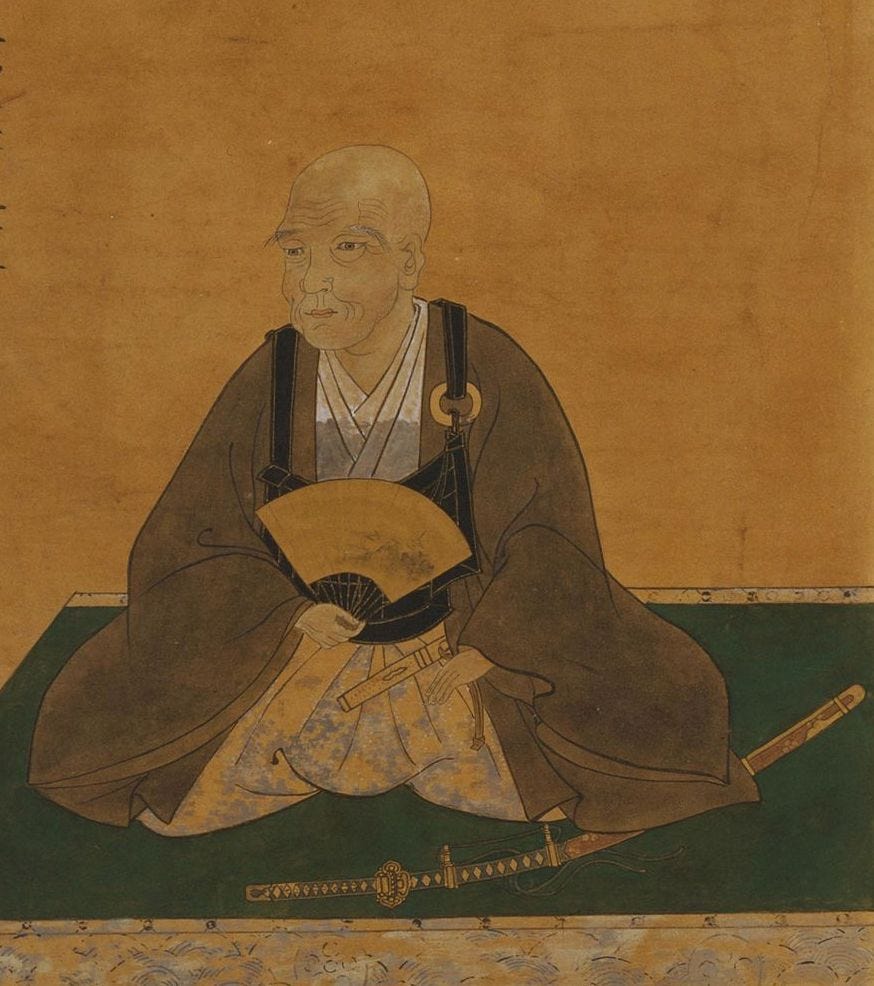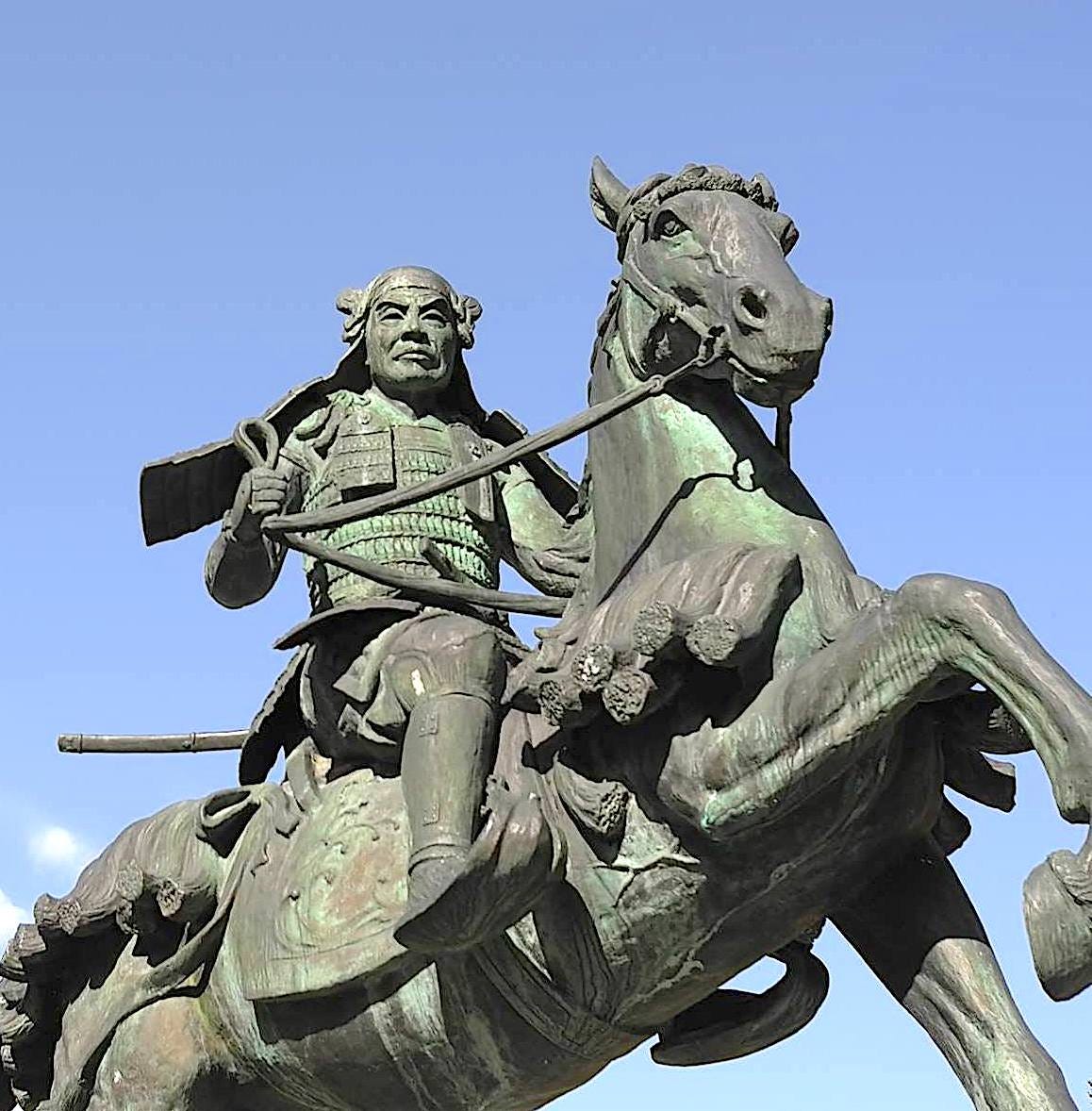The average lifespan of a samurai during the Sengoku period was around 45 years. Frontline warrior, warlord, and tea master Kanamori Nagachika died September 20, 1608, aged around 85 years of age! To have lived such a long life despite having participated in so many major battles is testament to his abilities, and to a degree, luck.
Originally named Kanamori Arichika, and commonly known as Gorohachi, Kanamori Nagachika was a Sengoku (Warring States) to early Edo period military commander and daimyo. Born in Ohata Village, Tajimi-go, Toki District, Mino Province (present-day Ohata Town, Tajimi City, Gifu Prefecture) in 1524, he was the second son of warrior Kanamori Sadachika and related to the Toki clan, Governors of Mino.
Nobunaga
Aged 18, he joined the forces of Oda Nobuhide in Owari Province, and through his exploits on the battlefield was chosen by Nobunaga to serve in the elite Red Horo brigade, sporting a red cloth balloon-like device on his back and acting as a mounted front-line messenger, and as a visual marker for Nobunaga to see how far his men had progressed in battle.
Held in high esteem, Kanamori was appointed a direct advisor to Nobunaga. When Nobunaga first went to Kyoto in 1559, Nagachika was one of the 80 people chosen to accompany him. The story goes that at thetime, Mino’s Saito Yoshitatsu sent assassins to kill Nobunaga, but Niwa Hyozo, a messenger from Owari, recognized them and informed Nagachika. It is said that Nagachika, who was acquainted with the Mino assassins, then went directly to their lodgings to greet them and declared that the matter had been exposed.
At the Battle of Nagashino Shitaragahara against Takeda Katsuyori in May of 1575, the Tokugawa generalSakai Tadatsugu suggested taking a roundabout route to a position behind the Takeda to make a successful surprise attack. Although it was Sakai’s idea, Nagachika co-led the forces.
As mentioned, Kanamori Nagachika was originally named Kanamori Arichika, but for his fine accomplishmentsat Nagashino, Nobunaga rewarded him with a character from his own name, 長Naga and so he became Kanamori Nagachika. For a samurai, this was quite an honor!
In August 1575, Nobunaga attempted to subjugate Echizen Province, where warrior monks were leading the Echizen Ikko Ikki Uprising. As such, Nagachika crossed the difficult Numimi Pass from Oku-Mino and entered Echizen Ono, scattering the army of the Hongan-ji Temple priest, Sugiura Gento, and pacifying the area in a short period of time. For suppressing the Echizen Ikko Ikki, Kanamori was awarded two-thirds of Ono County in Echizen Province, which he ruled from Ono Castle.
At the time of the attack on Kyoto’s Honno-ji Temple in which Oda Nobunaga was killed by Akechi Mitsuhide’s troops, Nagachika’s son, Naganori, was serving Nobunaga’ son, Nobutada at nearby Nijo Castle. Both were killed when the Akechi forces, having destroyed Nobunaga, turned their attentions on Nijo. Nagachika lost his lord, lord’s son and his own son on that fateful night in mid 1582. In mourning for all, Nagachika shaved his head, took the Buddhist tonsure, and built a sub-temple named Kinryu-in in Kyoto’s Daitoku-ji Temple to pray for his former master, Nobunaga, and son Naganori. Around this time, Nagachika adopted Nagaya Kizo — later re-named Kashige — a son of Nagaya Kageshige, lord of Itadori Taguchi Castle.
Hideyoshi
Following Nobunaga’s demise, Oda generals Shibata Katsuie and Toyotomi Hideyoshi came into conflict over Oda clan leadership. Nagachika sided with Shibata, who also had lands in Echizen. In 1583, Maeda Toshiie and Nagachika initially opposed Hideyoshi, however switching sides they retreated without a fight. Shibata Katsuie fell, and Maeda Toshiie and Kanamori Nagachika bowed to Hideyoshi.
Wanting to to subjugate Sassa Narimasa in Etchu, Hideyoshi ordered Nagachika into action, but the neighboring Anekoji clan, governors of Hida Province in northern Gifu since 1333 and courtiers to the Imperial Court, stopped them. Based in Kojima Castle, they had successfully rejected the offers and demands of Oda Nobunaga and later Toyotomi Hideyoshi time and again. In 1585, Kanamori Nagachika was ordered by Hideyoshi to capture the Hida region.
The Kanamori forces invaded Hida from the north and south in a pincer attack. The Anekoji clan resisted,expecting reinforcements from Sassa Narimasa, who, unknown to them was also under attack, and the Anekoji were forced to surrender. The Kanamori soon unified Hida Province, and was rewarded with the region and 38,700 koku. Nagachika made Hida Nabeyama Castle his residence, but in 1590 commenced building Takayama Castle on Mt. Tenjin. Said to have resembled Nobunaga’s famed Azuchi Castle, Takayama was completed around 1605 and the castle town of Hida Takayama, now a popular tourist destination, was developed.
Nagachika excelled at the aristocratic ball sport of kemari and in the tea ceremony. When Hideyoshi was based in Fushimi Castle, Nagachika built a tearoom in his home nearby, and often invited Hideyoshi to tea. He attended numerous tea ceremonies as a disciple of tea master Sen no Rikyu, and was close friends with the tea master and warrior, Furuta Oribe. When Toyotomi Hideyoshi ordered Sen no Rikyu to commit seppuku, Nagachika took a risk and hid Rikyu’s eldest son, Sen Doan, in Hida Takayama Castle.
During Hideyoshi’s invasion of Korea, Nagachika commanded 800 samurai while stationed in Hizen NagoyaCastle, Kyushu. Records show that when the ill Toyotomi Hideyoshi visited Arima Onsen hot springs, Nagachika — 12 or 13 years older that his lord — carried Hideyoshi on his back into the waters. On the death of Hideyoshi, Nagachika served Tokugawa Ieyasu.
Ieyasu
Aged 76, he led over 1,100 samurai at the Battle of Sekigahara. With his adopted son Kashige, he participated in the attack on the Uesugi, then the main battle against Ishida Mitsunari and other Western allies. Immediately after the Battle of Sekigahara, Nagachika is said to have climbed to the uppermost tower of Gifu Castle with Tokugawa Ieyasu, where they reminisced about Oda Nobunaga. The Kanamori father and son were laterpraised for their achievements and in addition to their former territory, were awarded 18,000 koku in Mugi, Mino Province, and their Kaneda, Kawachi Province (Kanaoka-cho, Kita-ku, Sakai City) was increased by 3,000 koku.
Both Ieyasu and his son, Hidetada, trusted him, and called him a ``man of spirit.'' In 1605, Ieyasu and Hidetada visited Nagachika's Fushimi residence together and enjoyed his hospitality.
In 1605, five years after the Battle of Sekigahara Nagachika finally retired aged 81.
He left the management of Hida Province and Takayama Castle to Kashige, and entered Ogurayama Castle (Mino City, Gifu Prefecture). The castle town remains as an important preservation district for traditional buildings. Nagachika’s youngest son, Nagamitsu was also born that year.
Death
Nagachika died visiting Fushimi, Kyoto. His domain in Hida was inherited by Kashige, his retirement property went to his infant son Nagamitsu, and the Kaneda property remained the residence of his wife, Kyushoin, who lived there until her death in 1625.
Kanamori Nagachika served all Three Unifiers, Nobunaga, Hideyoshi, and Ieyasu, becoming one of the most important military commanders of the Sengoku period. His many accomplishments, military exploits and important role in history have not been properly appraised by the history books, nor appreciated by later generations.






